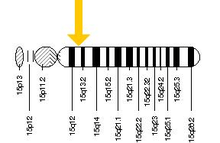HERC2
| View/Edit Human | View/Edit Mouse |

The HERC2 gene is located on the long (q) arm of chromosome 15 at position 13.
Probable E3 ubiquitin-protein ligase HERC2 is an enzyme that in humans is encoded by the HERC2 gene.[3][4]
A mutation in the HERC2 gene adjacent to OCA2, affecting OCA2's expression in the human iris, is found common to nearly all people with blue eyes. It has been hypothesized that all blue eyed humans share a single common ancestor with whom the mutation originated.[5][6][7]
The HERC2 gene's derived rs916977 allele is most common in Europe; particularly in the north and east, where it nears fixation. The variant is also found at high frequencies in North Africa, the Near East, Oceania and the Americas.[8]
References
- ↑ "Human PubMed Reference:".
- ↑ "Mouse PubMed Reference:".
- ↑ Ji Y, Walkowicz MJ, Buiting K, Johnson DK, Tarvin RE, Rinchik EM, Horsthemke B, Stubbs L, Nicholls RD (May 1999). "The ancestral gene for transcribed, low-copy repeats in the Prader-Willi/Angelman region encodes a large protein implicated in protein trafficking, which is deficient in mice with neuromuscular and spermiogenic abnormalities". Hum Mol Genet. 8 (3): 533–42. doi:10.1093/hmg/8.3.533. PMID 9949213.
- ↑ "Entrez Gene: HERC2 hect domain and RLD 2".
- ↑ Bryner J (2008-01-31). "Here's what made those brown eyes blue". Health News. MSNBC. Retrieved 2008-11-06.; Bryner J (2008-01-31). "One Common Ancestor Behind Blue Eyes". LiveScience. Imaginova Corp. Retrieved 2008-11-06.; "Blue-eyed humans have a single, common ancestor". News. University of Copenhagen. 2008-01-30. Retrieved 2008-11-06.
- ↑ Eiberg H, Troelsen J, Nielsen M, Mikkelsen A, Mengel-From J, Kjaer KW, Hansen L (March 2008). "Blue eye color in humans may be caused by a perfectly associated founder mutation in a regulatory element located within the HERC2 gene inhibiting OCA2 expression". Human Genetics. 123 (2): 177–87. doi:10.1007/s00439-007-0460-x. PMID 18172690.
- ↑ Sturm RA, Duffy DL, Zhao ZZ, Leite FP, Stark MS, Hayward NK, Martin NG, Montgomery GW (February 2008). "A Single SNP in an Evolutionary Conserved Region within Intron 86 of the HERC2 Gene Determines Human Blue-Brown Eye Color". American Journal of Human Genetics. 82 (2): 424–31. doi:10.1016/j.ajhg.2007.11.005. PMC 2427173
 . PMID 18252222.
. PMID 18252222. - ↑ "Allele Frequency For Polymorphic Site: rs916977". ALFRED. Retrieved 22 June 2016.
Further reading
- Nagase T, Ishikawa K, Nakajima D, et al. (1997). "Prediction of the coding sequences of unidentified human genes. VII. The complete sequences of 100 new cDNA clones from brain which can code for large proteins in vitro.". DNA Res. 4 (2): 141–50. doi:10.1093/dnares/4.2.141. PMID 9205841.
- Walkowicz M, Ji Y, Ren X, et al. (1999). "Molecular characterization of radiation- and chemically induced mutations associated with neuromuscular tremors, runting, juvenile lethality, and sperm defects in jdf2 mice.". Mamm. Genome. 10 (9): 870–8. doi:10.1007/s003359901106. PMID 10441737.
- Ji Y, Rebert NA, Joslin JM, et al. (2000). "Structure of the highly conserved HERC2 gene and of multiple partially duplicated paralogs in human.". Genome Res. 10 (3): 319–29. doi:10.1101/gr.10.3.319. PMC 311424
 . PMID 10720573.
. PMID 10720573. - Dias Neto E, Correa RG, Verjovski-Almeida S, et al. (2000). "Shotgun sequencing of the human transcriptome with ORF expressed sequence tags.". Proc. Natl. Acad. Sci. U.S.A. 97 (7): 3491–6. doi:10.1073/pnas.97.7.3491. PMC 16267
 . PMID 10737800.
. PMID 10737800. - Xu XR, Huang J, Xu ZG, et al. (2002). "Insight into hepatocellular carcinogenesis at transcriptome level by comparing gene expression profiles of hepatocellular carcinoma with those of corresponding noncancerous liver.". Proc. Natl. Acad. Sci. U.S.A. 98 (26): 15089–94. doi:10.1073/pnas.241522398. PMC 64988
 . PMID 11752456.
. PMID 11752456. - Strausberg RL, Feingold EA, Grouse LH, et al. (2003). "Generation and initial analysis of more than 15,000 full-length human and mouse cDNA sequences.". Proc. Natl. Acad. Sci. U.S.A. 99 (26): 16899–903. doi:10.1073/pnas.242603899. PMC 139241
 . PMID 12477932.
. PMID 12477932. - Ota T, Suzuki Y, Nishikawa T, et al. (2004). "Complete sequencing and characterization of 21,243 full-length human cDNAs.". Nat. Genet. 36 (1): 40–5. doi:10.1038/ng1285. PMID 14702039.
- Brandenberger R, Wei H, Zhang S, et al. (2005). "Transcriptome characterization elucidates signaling networks that control human ES cell growth and differentiation.". Nat. Biotechnol. 22 (6): 707–16. doi:10.1038/nbt971. PMID 15146197.
- Fu GK, Wang JT, Yang J, et al. (2005). "Circular rapid amplification of cDNA ends for high-throughput extension cloning of partial genes.". Genomics. 84 (1): 205–10. doi:10.1016/j.ygeno.2004.01.011. PMID 15203218.
- Olsen JV, Blagoev B, Gnad F, et al. (2006). "Global, in vivo, and site-specific phosphorylation dynamics in signaling networks.". Cell. 127 (3): 635–48. doi:10.1016/j.cell.2006.09.026. PMID 17081983.
- Ewing RM, Chu P, Elisma F, et al. (2007). "Large-scale mapping of human protein-protein interactions by mass spectrometry.". Mol. Syst. Biol. 3 (1): 89. doi:10.1038/msb4100134. PMC 1847948
 . PMID 17353931.
. PMID 17353931. - Sulem P, Gudbjartsson DF, Stacey SN, et al. (2007). "Genetic determinants of hair, eye and skin pigmentation in Europeans.". Nat. Genet. 39 (12): 1443–52. doi:10.1038/ng.2007.13. PMID 17952075.
| Wikimedia Commons has media related to HERC2. |
This article is issued from Wikipedia - version of the 6/22/2016. The text is available under the Creative Commons Attribution/Share Alike but additional terms may apply for the media files.

